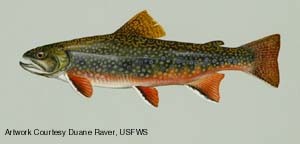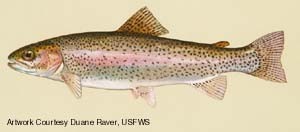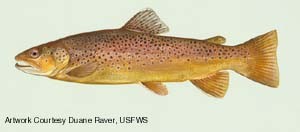Trout Species in Tennessee
Brook Trout
Brook Trout are Tennessee’s only native trout species, which have been found to be genetically distinct from Brook Trout native to more northern parts of its range.
At one time, all wild trout water in Tennessee was inhabited by Brook Trout. However, in the late 1800s many populations were lost due to primitive logging techniques and stocking of non-native Rainbow Trout. Wild populations can now only be found in the coldest and cleanest headwater streams in the mountains of eastern Tennessee at elevations greater than 3,000 feet where water temperatures are typically below 68° F. TWRA biologists, in cooperation with the US Forest Service, Great Smoky Mountain National Park, Tennessee Aquarium and Trout Unlimited have recently worked to expand the range of Brook Trout by stocking native strains back into their native waters.
Today, we have about 150 streams that support wild Brook Trout. For additional information on TWRA’s efforts to restore native Southern Appalachian Brook Trout populations across East Tennessee, check out of this episode of Tennessee’s Wild Side.
Additional Information
Identification: Yellow or reddish-orange spots on sides and belly. Light wormlike markings on the upper body. Leading edge of lower fins white with black stripe.
State Record: 4 lbs, 12 oz. (Caney Fork River)
Fishing Tips: Brook Trout are aggressive feeders eating insects, crayfish, salamanders, and other fish. Food is typically in short supply in headwater streams so Brook Trout rely heavily on prey that falls into the stream (e.g., ants, caterpillars, inchworms).
Rainbow Trout
Rainbow Trout are native to the Pacific drainages of the western United States, but through extensive trout management during much of the 20th century has become the most widely distributed and abundant trout species in Tennessee.
Rainbows were originally introduced into Tennessee in the late 1880s when logging practices destroyed native Brook Trout habitat.
Wild populations are now found in about 300 streams across East Tennessee. Rainbow Trout spawn in late winter and their juvenile hatch out in early spring. They can tolerate temperature slightly warmer than Brook Trout, preferring water temperatures below 70° F.
Additional Information
Identification: Body olive to silver in color. Small black spots throughout the body that extend into the bottom of the tail. Pink streak along middle of the body.
State Record: 18 lbs, 8 oz. (Private Pond)
Fishing Tips: Rainbow Trout eat insects, crayfish, fish, and fish eggs. They are susceptible to a wide variety of tackle. Fly-fishing with streamers, wet and dry flies can be effective. Spinning and bait casting tackle includes small spinners, spoons, worms, and hellgramites.
Brown Trout
Brown Trout are native to Europe and Asia and, like Rainbows, became naturalized in Tennessee through stocking. They are typically found in lower elevation streams, often coexisting with Rainbow Trout.
They spawn in the fall between October and November, and juveniles emerge in February or March. Common in about 25 wild streams, Brown Trout offer the best opportunity to catch a trophy trout in Tennessee. Tennessee’s wild Brown Trout can live twice as long and attain much greater sizes than either Rainbow or Brook trout.
Additional Information
Identification: Brown to yellowish body color. Large dark spots and reddish dots, many having halos. Slightly forked tail with no spots.
State Record: 28 lbs, 12 oz. (Clinch River)
Fishing Tips: Young Brown Trout feed mostly on aquatic insects, small crayfish and minnows. Adults will feed on fish, crayfish, rodents, and salamanders. Large browns tend to feed during low light conditions and after dark. Typical trout baits and lures work for Brown Trout, but slightly larger tackle may help catch trophy sized fish.



